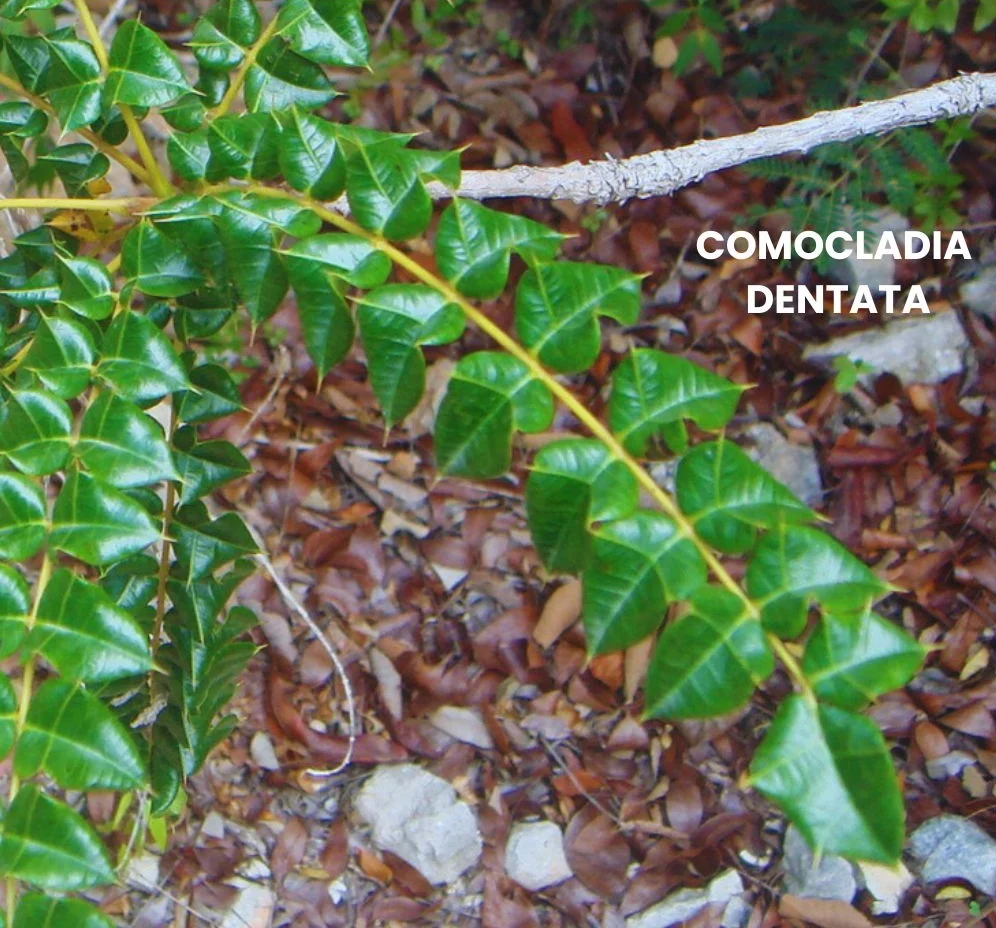Comocladia dentata, commonly known as Guao, is a plant native to tropical regions of the Americas, particularly the Caribbean.
This plant is part of the Anacardiaceae family and is known for its significant medicinal properties, especially in homeopathy.
It is used to treat various conditions affecting the eyes, skin, and joints.
Despite its therapeutic benefits, it must be handled with caution due to its potential to cause severe skin irritation.

Table of Contents
ToggleSOURCE INFORMATION
Scientific Classification
- Kingdom: Plantae
- Clade: Angiosperms
- Order: Sapindales
- Family: Anacardiaceae
- Genus: Comocladia
- Species: C. dentata
Common Name: Guao
Origin and Habitat
- Comocladia dentata is native to tropical regions of the Americas, particularly the Caribbean.
- It thrives in warm, humid climates and is commonly found in forests and thickets.
Historical and Medicinal Use
- Traditionally, indigenous peoples and practitioners of folk medicine have used various parts of the Comocladia dentata plant for its supposed medicinal properties.
- However, it is also known to cause severe skin irritation and is handled with caution.
- In homeopathy, it is used for specific symptoms related to the eyes, skin, and joints, and for its effects on the antrum and sacro-iliac regions.
DRUG PATHOGENESIS
- Comocladia dentata primarily affects the skin and mucous membranes, inducing symptoms that resemble conditions like erysipelas and eczema.
- It also impacts the eyes, causing neuralgic pains and a sensation of fullness.
- It is particularly noted for its effect on joint pain and abdominal discomfort.
KEY CHARACTERISTICS
EYES
- Ciliary neuralgia with a sensation of large, protruding eyes, especially on the right side.
- Symptoms worsen near heat sources like a warm stove.
- Glaucoma with a sense of fullness in the eyeball.
- Motion of the eyes aggravates the symptoms.
FACE
- Swelling, with eyes appearing to project outward.
SKIN
- Itching and red pimples.
- Redness similar to that seen in scarlet fever (scarlatina).
- Erysipelas, a bacterial infection causing red, swollen, and painful skin.
- Deep ulcers with hard edges.
- Leprosy-like lesions.
- Red stripes on the skin.
- Papular and pustular eczema affecting the trunk and extremities.
CHEST
- Acute pain in the left mammary gland.
- Pain extending from the right side of the chest down the arm to the fingers.
- Cough with pain under the left breast, radiating through to the left scapula.
MODALITIES
- Better: In open air, by scratching, and with motion.
- Worse: By touch, warmth, rest, and at night.
RELATIONSHIP WITH OTHER DRUGS
Compare with
- Rhus tox: Known for treating similar skin conditions and joint pain.
- Anacardium: Useful for skin and mental symptoms.
- Euphorbium: Another remedy for skin eruptions and ulcerations.
DOSE
- Potency: First to thirtieth potency, depending on the severity and type of symptoms.
Frequently Asked Questions (FAQs)
What conditions is Comocladia dentata used for in homeopathy?
- It is primarily used for eye conditions like ciliary neuralgia and glaucoma, skin conditions such as erysipelas and eczema, and joint pains, particularly in the ankles and sacro-iliac regions.
How does Comocladia dentata affect the eyes?
- It causes neuralgic pain with a sensation of the eyes being large and protruding, and symptoms worsen with heat and eye movement.
What are the common skin symptoms treated by Comocladia dentata?
- It treats itching, red pimples, erysipelas, deep ulcers with hard edges, and various forms of eczema.
What are the modalities of Comocladia dentata?
- Symptoms improve in open air, by scratching, and with motion. They worsen with touch, warmth, rest, and at night.
Glossary of Difficult Words
- Ciliary Neuralgia: Pain along the ciliary nerves, which can affect the eyes.
- Glaucoma: A condition of increased pressure within the eyeball, causing gradual loss of sight.
- Erysipelas: A bacterial infection of the skin’s outer layers.
- Leprosy: A chronic infectious disease-causing skin lesions and nerve damage.
- Eczema: A condition that makes the skin red, inflamed, and itchy.
- Antrum: A natural chamber or cavity within a bone.
